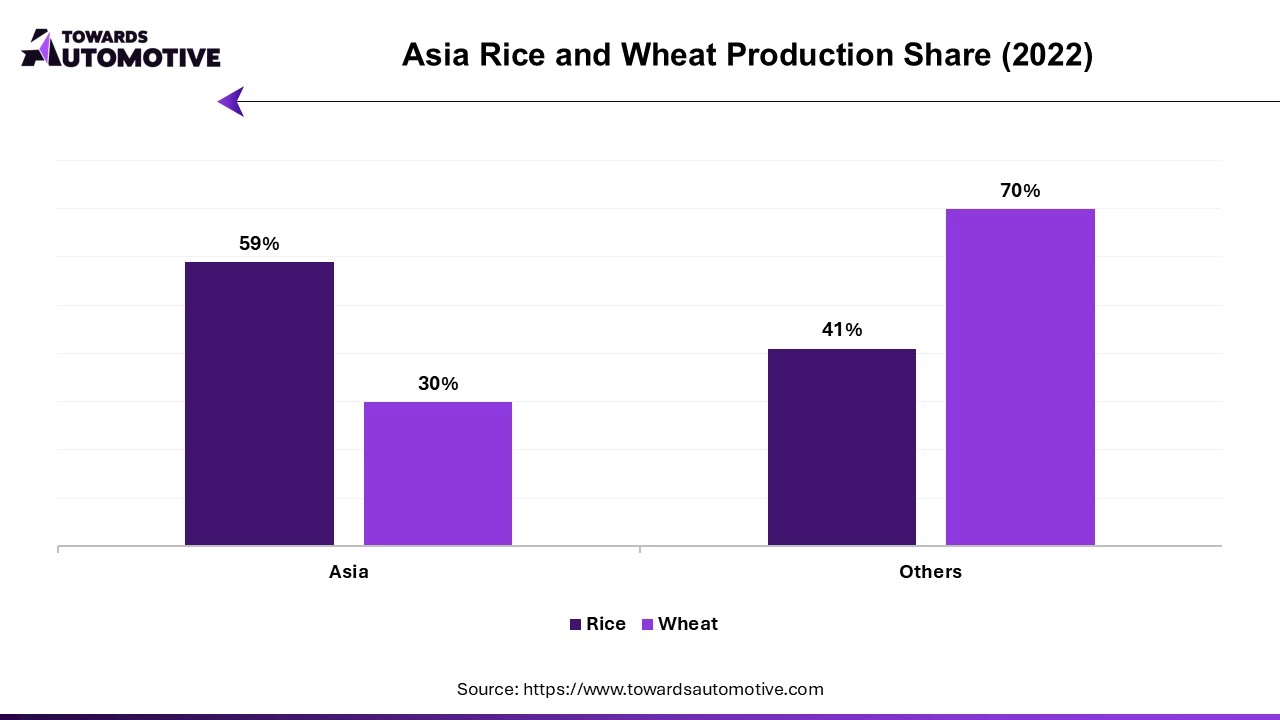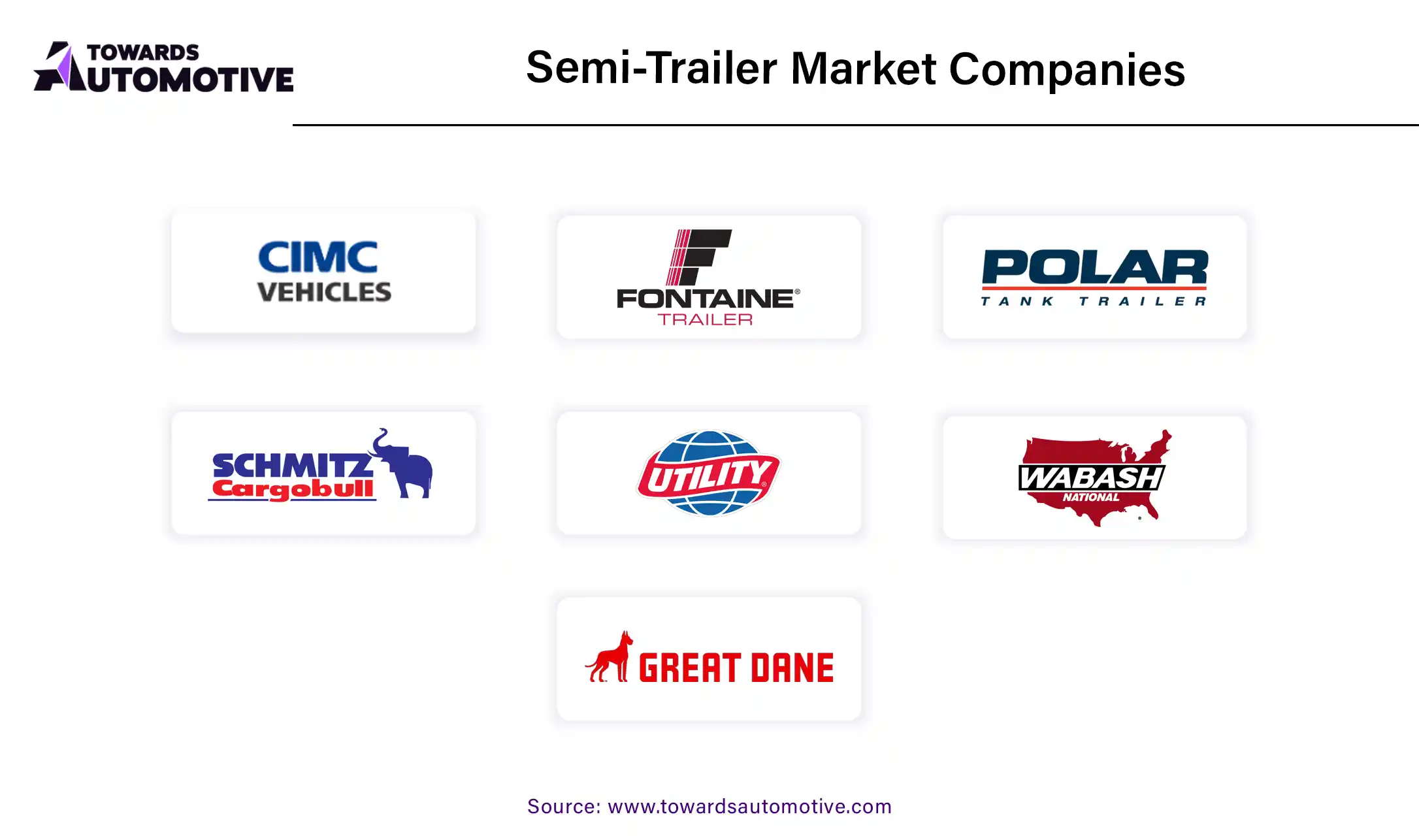April 2025

Senior Research Analyst

Reviewed By
The semi-trailer market is projected to reach USD 59.30 billion by 2034, growing from USD 38.47 billion in 2025, at a CAGR of 5.15% during the forecast period from 2025 to 2034.

The semi-trailer market is a crucial segment within the broader transportation and logistics industry, characterized by its ability to facilitate the efficient movement of goods across various distances. Semi-trailers are non-motorized vehicles designed to be towed by a tractor unit, allowing for greater flexibility and capacity in freight transportation. Their unique design features a detachable coupling system that enables quick loading and unloading, significantly reducing downtime for logistics operators. This efficiency is vital for industries reliant on just-in-time inventory systems, where timely delivery is critical to maintaining supply chain fluidity.
Several factors are driving growth in the semi-trailer market. Firstly, the surge in e-commerce has led to an increased demand for logistics services, compelling companies to invest in robust transportation solutions, including semi-trailers, to meet consumer expectations for rapid delivery. Furthermore, the global push for sustainability and reduction of carbon emissions is fostering the development of lightweight and energy-efficient semi-trailer designs, which can optimize fuel consumption and reduce overall operational costs. This trend is particularly important as companies seek to align their operations with stringent environmental regulations and consumer preferences for sustainable practices.
Moreover, technological advancements are playing a significant role in the semi-trailer market. Innovations such as telematics systems, which provide real-time tracking and monitoring of trailers, have become increasingly integrated into semi-trailer designs. This technology enables fleet operators to enhance route planning, manage maintenance schedules proactively, and improve overall operational efficiency. Additionally, advancements in materials and manufacturing processes are resulting in stronger, lighter, and more durable semi-trailers, further contributing to their appeal in the logistics sector.
Artificial Intelligence (AI) is increasingly playing a transformative role in the semi-trailer market, enhancing efficiency, safety, and operational management. One of the primary applications of AI in this sector is predictive maintenance. By analyzing data from various sensors embedded in semi-trailers, AI algorithms can predict potential failures or maintenance needs before they become critical issues. This proactive approach reduces downtime and repair costs while improving the overall reliability of the fleet.
Additionally, AI enhances route optimization for logistics companies. Machine learning algorithms can analyze traffic patterns, weather conditions, and other factors to determine the most efficient routes for transporting goods. This capability not only saves time and fuel costs but also improves delivery schedules, leading to higher customer satisfaction. AI-driven routing can adapt in real time, allowing for dynamic adjustments based on changing conditions, further optimizing logistics operations.
In terms of safety, AI systems can be integrated into semi-trailer designs to monitor various parameters, such as load weight and distribution. These systems help prevent overloading and ensure compliance with legal regulations, reducing the risk of accidents. Moreover, AI can enhance driver assistance technologies, such as collision avoidance systems and lane-keeping assistance, contributing to safer roadways.
Furthermore, AI is instrumental in fleet management. AI-driven platforms can analyze performance data, driver behavior, and fuel consumption metrics to identify inefficiencies and recommend improvements. This data-driven approach helps fleet operators optimize their operations, reduce costs, and enhance overall performance.
The increasing demand for dry vans is driving significant growth in the semi-trailer market due to their versatile and secure cargo transportation capabilities. Dry vans, designed as enclosed trailers, protect goods from external elements like weather and road conditions, making them an ideal choice for transporting non-perishable goods, electronics, furniture, clothing, and other consumer products. The rise in e-commerce activities, especially with the surge in online shopping, has amplified the demand for efficient, secure, and reliable transportation solutions, positioning dry vans as a key solution in this sector.
Additionally, the growth in retail, manufacturing, and logistics industries has created a heightened need for consistent and dependable freight solutions. Dry vans are popular among these sectors because of their ability to haul large volumes of goods across long distances while keeping the cargo safe and organized. With increasing supply chain complexity and the need for just-in-time deliveries, the demand for dry vans has risen sharply as companies seek to optimize logistics and inventory management.
The expansion of infrastructure and road networks also supports the growth of the semi-trailer market, as it facilitates the movement of goods across regional and international borders, with dry vans being a primary transport mode. As businesses continue to expand and streamline distribution networks, the rising demand for dry vans will remain a key factor in driving the overall growth of the semi-trailer market.
The semi-trailer market faces several restraints that hinder its growth. One major challenge is the high initial cost of purchasing semi-trailers, which can be prohibitive for smaller businesses. Additionally, fluctuating fuel prices significantly impact operational costs, reducing profitability for freight operators. Strict government regulations regarding emissions and road safety also increase compliance costs. Moreover, driver shortages and high maintenance requirements further limit market expansion. Economic downturns or disruptions in global trade can also affect demand for transportation services, leading to reduced investments in semi-trailers and slowing overall market growth.
Electric-powered semi-trailers are creating significant opportunities in the semi-trailer market as the industry shifts toward more sustainable and efficient transportation solutions. With rising concerns about environmental impact and stringent emissions regulations, electric semi-trailers offer a viable alternative to traditional diesel-powered vehicles. These innovative trailers are designed to operate on electric power, resulting in reduced greenhouse gas emissions and lower fuel costs, making them attractive to fleet operators seeking to enhance their sustainability profiles.
As technology advances, electric semi-trailers are becoming increasingly viable for long-haul transportation. Enhanced battery technologies and improved charging infrastructure are enabling these vehicles to cover longer distances without compromising performance. Additionally, government incentives and subsidies for electric vehicle adoption are further driving interest in electric-powered semi-trailers, encouraging logistics companies to invest in these eco-friendly options.
Furthermore, electric semi-trailers can integrate with smart logistics systems, enabling real-time data tracking and route optimization, which enhances operational efficiency. This technological integration helps fleets reduce downtime and improve delivery times, creating a competitive edge in the logistics sector. As the demand for cleaner transportation solutions continues to grow, electric-powered semi-trailers are poised to become a cornerstone of the semi-trailer market, fostering innovation and contributing to a more sustainable future in the freight industry.
The low boy trailers segment held the largest share of the market. Low boy trailers are significantly contributing to the growth of the semi-trailer market due to their unique design and capability to transport oversized and heavy loads. Characterized by a lower deck height, these trailers enable the safe and efficient transportation of tall and bulky equipment, such as construction machinery, industrial equipment, and large vehicles. The increasing demand for infrastructure development and construction projects across various sectors is propelling the need for low boy trailers. As governments and private entities invest in new infrastructure, including roads, bridges, and commercial buildings, the requirement for transporting heavy machinery to job sites has surged, consequently driving the demand for low boy trailers.
Moreover, the rise of renewable energy initiatives, particularly in sectors like wind and solar energy, has further fueled the growth of the low boy trailer market. Wind turbine components, such as nacelles and blades, often require specialized transportation solutions like low boy trailers due to their size and weight. This trend is expected to continue as countries strive to transition to cleaner energy sources, necessitating the transport of large equipment.
The versatility of low boy trailers also plays a crucial role in their growing popularity. They are designed to accommodate various types of loads, making them suitable for a wide range of industries, including construction, agriculture, mining, and heavy manufacturing. This adaptability ensures that low boy trailers can meet diverse customer needs, thus enhancing their market appeal.
Additionally, advancements in low boy trailer technology, such as improved braking systems, enhanced safety features, and lightweight materials, are increasing their efficiency and effectiveness. These innovations contribute to better load management and fuel efficiency, making low boy trailers a more attractive option for businesses aiming to optimize their transportation operations.

Asia Pacific dominated the semi-trailer market. The semi-trailer market in the Asia-Pacific (APAC) region is witnessing robust growth, primarily driven by rapid industrialization and urbanization, agricultural and food transportation needs, government initiatives, and infrastructure investments. The ongoing industrialization across APAC countries, particularly in China and India, has led to increased manufacturing and production activities. This surge necessitates efficient logistics solutions to transport goods, making semi-trailers essential for freight transportation. As urban areas expand, the demand for goods and services rises, leading to heightened logistics requirements. Semi-trailers play a crucial role in fulfilling these needs by facilitating the movement of large quantities of products over long distances.
Moreover, the agricultural sector significantly contributes to the growth of the semi-trailer market. The need to transport perishable goods, including fruits, vegetables, and dairy products, necessitates the use of refrigerated semi-trailers. As agriculture becomes more commercialized in many APAC countries, the demand for specialized semi-trailers equipped for food transportation is on the rise, promoting market expansion.
Government initiatives aimed at enhancing transportation efficiency and logistics capabilities further bolster the semi-trailer market. Governments in the region are investing in policies and programs that promote the modernization of the logistics sector. These initiatives often include financial incentives for upgrading fleets, improving logistics operations, and enhancing the regulatory framework, all of which create a conducive environment for the semi-trailer market to thrive.
Infrastructure investment also plays a pivotal role in driving market growth. The development of new highways, roads, and logistics parks is essential for improving transportation efficiency. As governments prioritize infrastructure upgrades to accommodate growing freight volumes, the demand for semi-trailers will continue to rise. Collectively, these factors underscore the dynamic landscape of the APAC semi-trailer market, where industrial growth, agricultural needs, supportive government policies, and infrastructure development converge to create significant opportunities for manufacturers and operators alike.

North America is expected to grow with a significant CAGR during the forecast period. The semi-trailer market in North America is experiencing significant growth, driven by strong freight demand, the expansion of e-commerce, and technological advancements. The freight transportation sector is booming, fueled by a robust economy that relies heavily on the efficient movement of goods across the continent. With consumer demand increasing, businesses are ramping up their logistics capabilities to meet the needs of both traditional retail and e-commerce. This heightened freight demand necessitates the use of semi-trailers, as they are crucial for transporting goods in bulk, ensuring that products reach their destinations promptly and efficiently.
E-commerce expansion is another major factor propelling the semi-trailer market in North America. The rapid growth of online shopping has transformed the logistics landscape, leading to increased shipping volumes. Companies are investing in larger fleets of semi-trailers to facilitate the timely delivery of goods to customers. With the rise of last-mile delivery services, semi-trailers are essential for transporting products to distribution centers, where they can be dispatched to consumers' doorsteps. This shift in consumer behavior towards online shopping has created a sustained demand for semi-trailer transport solutions.
Technological advancements are further driving the growth of the semi-trailer market. Innovations such as telematics, advanced logistics software, and automation are enhancing the efficiency and effectiveness of freight operations. Telematics systems provide real-time data on vehicle performance, helping fleet operators optimize routes and reduce fuel consumption, which is increasingly important in a competitive market. Moreover, the integration of automation technologies, including autonomous driving systems, is expected to revolutionize the industry, improving safety and operational efficiency. As these technologies become more prevalent, the semi-trailer market is positioned for robust growth, catering to the evolving needs of the logistics sector in North America. Together, these factors underscore a dynamic market landscape, where strong freight demand, e-commerce growth, and technological innovation create abundant opportunities for semi-trailer manufacturers and operators.


By Type
By Region
April 2025
April 2025
April 2025
April 2025
Dr. Arjun Patel is a distinguished expert in the automotive industry, holding advanced degrees in Automotive Engineering and Mechanical Engineering. His expertise spans automotive market dynamics, technological advancements, and sustainable practices. Dr. Patel excels in conducting in depth research and analysis on market trends, consumer preferences, and the economic implications within the automotive sector. He is renowned for his insightful publications on topics such as electric vehicles, autonomous driving technologies, and the evolution of sustainable transportation solutions. Dr. Patels research contributions have significantly advanced understanding in the field, earning him recognition as a leading authority in automotive research and analysis.
We offer automotive expertise for market projections and customizable research, adaptable to diverse strategic approaches.
Contact Us